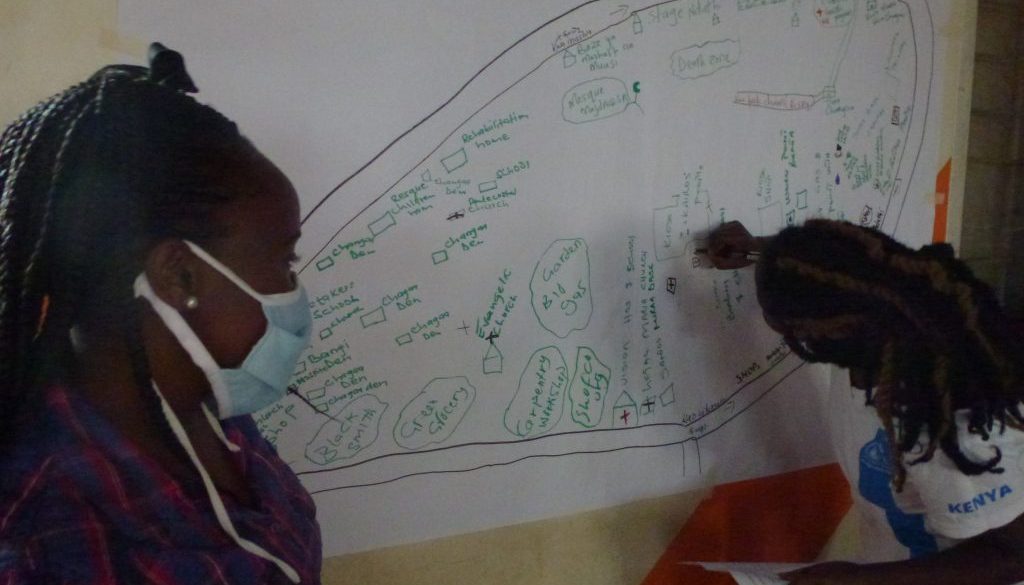“It puts value on the people” Community Based Participatory Research in Kenya
Faith Munyao, Veronicah Mwania and Beate Ringwald conduct a community based participatory research (CBPR) study on prevention of intimate partner violence and HIV in Gitathuru, Korogocho, Nairobi, Kenya. In this blog they share their experience of conducting this ARISE-affiliated project together.
Beate: After working from home for five months, I was excited about the restart of the study (my PhD research project) in August. It has already been a great learning journey for me, and I am grateful that you have joined me. I have been exposed to participatory group work since my time as a youth leader in my local parish. Since then, I have used it a lot in my work. But this is the first time that you have used a participatory approach to research. How do you like it?
Faith: It is a unique kind of research, because the community is fully engaged.
Veronicah: I love it. To me, this is the best approach that I have experienced so far. The participatory research approach puts value on the people. The community is involved in the research and drives the process. It gives people the time to digest information. It does not impose foreign ideas on the community, is very inclusive, and empowers the community.
Faith: This is an opportunity to learn how research with communities can be done differently. I like about the participatory approach to see how eager community co-researchers are to learn and come up with ideas on how to do things. For example, they came up with a name for themselves. The community co-researchers are involved in all steps of the study, unlike in other studies where they are mainly engaged as informants during data collection or involved as data collectors. I like the formation of the local research team and the capacity building of the community co-researchers. When discussing their tasks with them, they were free to say what they want and what they do not want to do.
Veronicah: The participatory approach creates partnerships between community members, national and international researchers. For this long-term engagement, ethical considerations become an ongoing process throughout the study and are not a one-off exercise.
Beate: It sounds like you see great potential in participatory research. What are its benefits?
Veronicah: Participatory research, especially the visual methods that we use, offers unique learning about the study topic. It also gives us as researchers time to learn as we go and adjust. Regular debriefing has proven to be very useful.
Faith: Researchers are likely to get more information, because visual methods offer new ways of seeing. They do not restrict participants on what to say and not to say. I also see that the community co-researchers feel appreciated. They are given the opportunity to share the problems at the community. The weekly meetings and reflections give them also the time to digest information.
Veronicah: I agree. The community is fully engaged in identifying the problem and seeking solutions. In the process, capacity of community co-researchers is built. I hope by the end of the study we will be leaving the community impacted.
Beate: As you mentioned, participatory research involves long-term engagement with the community. This is different from many other studies whereby community members are met once for a short period of time. What challenges do you foresee, and how could we mitigate them?
Faith: So far, time has been a challenge. Everything takes longer than anticipated, including time for tea breaks, an important time for bonding and socialising.
Beate: True, we often have ambitious time plans. Time indicated in guidelines for methods is usually underestimated. I am learning how to make more feasible plans for our meetings and give room for in-depth discussions.
Veronicah: The study requires commitment of community co-researchers over a long period of time, with regular meetings on Saturday mornings. It is challenging if co-researchers are missing meetings due to other commitments. Being flexible and adjusting meeting times to dates when many are available has been useful.
Beate: We are still at the beginning of the study. I am looking forward to the joined data collection and analysis with co-researchers. What are you looking forward to?
Veronicah: I look forward to finalizing the definition of intimate partner violence and to discussions on power dynamics in the community that influence HIV and intimate partner violence risk. I also want to see us achieving the study objectives. I can’t wait to see the impact of the study on the community.
Faith: I am curious to explore with the community how intimate partner violence and HIV intersect and the solutions that they will come up with. Also, I am looking forward to seeing sustainability and ownership of the project by the community.
Beate: This is awesome. Thank you very much, Faith and Vero for sharing your experiences and reflections on community based participatory research with me and the ARISE family.
About us
Faith Munyao is a Kenyan researcher with four years of experience in HIV and Gender Based Violence-related qualitative research.
Veronicah Mwania is a Kenyan researcher with 17 years of experience in market research and health research.
Beate Ringwald has five years of experience in desk-based global health research and over ten years of experience in participatory work with youth, women and communities.
Within the ARISE Hub, this research project is a partnership between LSTM, LVCT Health and Gitathuru village. The study seeks to strengthen community capacity to prevent intimate partner violence and HIV in Gitathuru, Korogocho, Nairobi, Kenya. It is guided by the ALIV[H]E framework, which stands for Action Linking Initiatives on Violence against women and HIV Everywhere. Locally the study is known as the Korogocho ALIV[H]E study.
